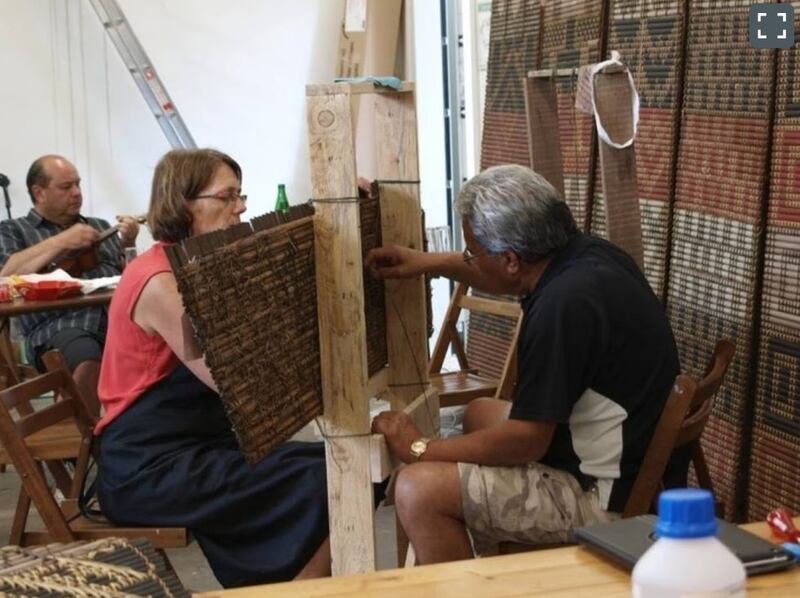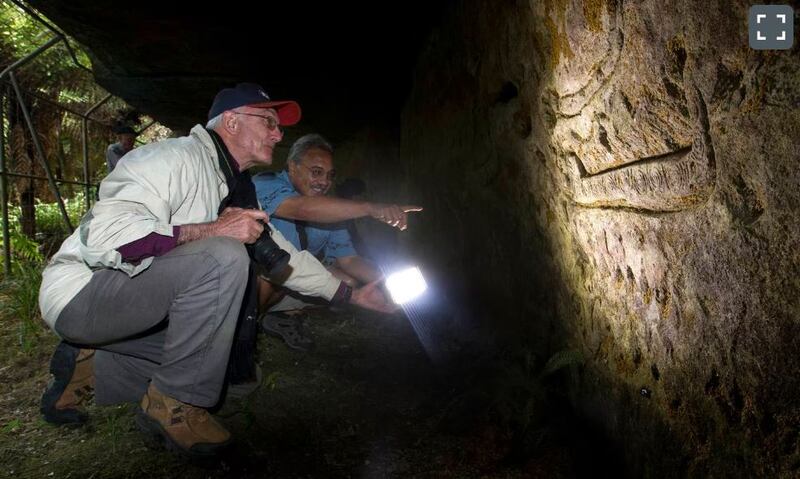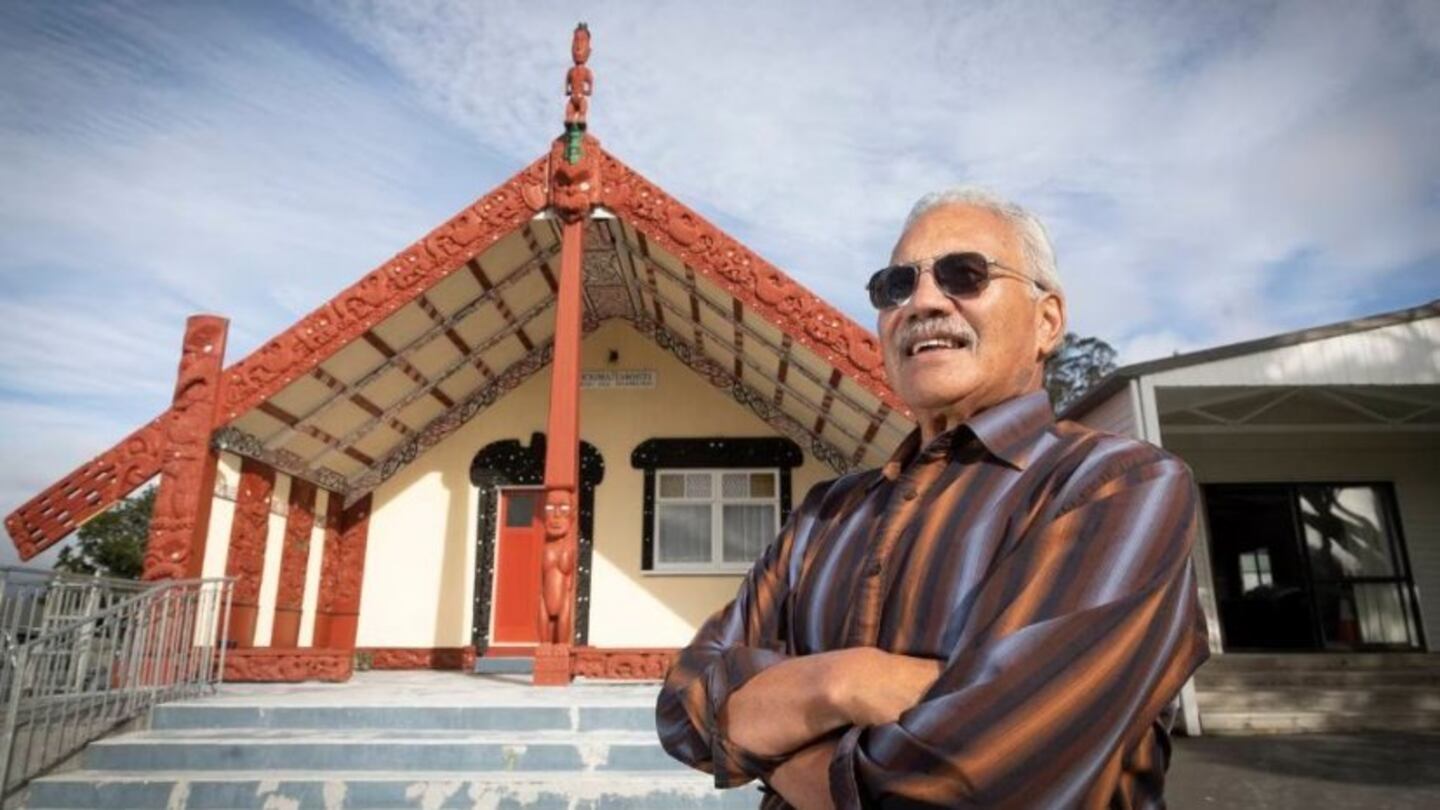Jim Schuster is a specialist carver, kowhaiwhai painter and tukutuku weaver. Photo / Andrew Warner
By Maryana Garcia, NZ Herald
When asked what he does for a living, Jim Schuster’s answer is simple:
“I do real feel-good mahi.”
Schuster, of Te Arawa, Ngāti Pikiao, Ngāti Hinekura, Tuhourangi, Ngāti Wahiao, Ngāti Tarawhai, Tuwharetoa and Ngāti Umutahi, is an expert in Māori conservation techniques and has restored Māori buildings of local, national and historical significance in New Zealand and overseas for 20 years.
“The work makes you feel good because you restore the meeting house and people feel good when their meeting house is looking brand new again,” Schuster told the Rotorua Daily Post.
Today, Schuster is being recognised for his “feel-good mahi” in the King’s Birthday and Coronation Honours list as an Officer of the New Zealand Order of Merit.
Schuster said he was surprised to get a letter from Governor-General Dame Cindy Kiro’s office asking if he’d like to accept the honour.
“That’s not something that happens every day,” Schuster said.
“I thought, ‘Do I really deserve or want this?’”
For Schuster, the decision to accept the recognition wasn’t easy. He needed time to think about it.
“Then I thought about all the people who have helped me, who have nurtured me, who have taught me and I said, ‘This is for them’.
“I will accept this as an acknowledgement of all the learning and the teaching I have had in this work I do. Particularly from my kuia and koroua, my mum and my dad.”
Schuster, a specialist carver, kowhaiwhai painter and tukutuku weaver, has been a Māori built heritage adviser for Heritage New Zealand since 2003.
But his real bosses, Schuster said, are the ancestors of each tipuna whare (ancestral house) where he works.
“While I’m working on [the ancestor’s house] he’s my boss. While I’m onsite, my work is for him. I’ll do everything to fix him up, to give him a makeover,” Schuster said.
“That way I feel safe, especially when I’ve got to climb high up on scaffolding and I’ve got to work on the carvings right on top of the marae.
“I know he’s got my back. He’s going to look after me and if I fall I know he’s going to be there to catch me.”

Cathy and Jim Schuster at work on Rauru in Germany. Source / NZ Herald
Schuster said he has visited almost all of the marae in the North Island. However, the Tūtānekai meeting house at Rotorua’s Ōwhata Marae holds a special place in his heart.
“That was one of the first big major jobs that I did,” Schuster said.
The Tūtānekai meeting house was damaged by a fire in 2003.
“I was working at another marae when the fire happened. Everybody else who I was working next to told me to help Tūtānekai first. So, I went straight there.”
Schuster said the project was his focus for the next 18 months.
“It wasn’t only about restoring the meeting house but restoring the mātauranga Māori [knowledge] around it.”
Schuster said the time he spent working on Tūtānekai made him feel like he had become part of the building.
“It was hard to leave. I had an empty space in my heart. I moved on to the next project but I’ll always remember that one.
“It’s satisfying to see a burnt-out shell and be able to bring it back to life.”

Jim Schuster (right) showing world-renowned French prehistorian Dr Jean Clottes rock art near Murupara. Photo / Alan Gibson
Schuster has contributed to the restoration of many marae and wharenui of regional and national significance, recently completing work on the former Māori Affairs Committee Room at Parliament.
He led a restoration project of the Rauru Meeting House in Fur Volkerkunde Museum in Hamburg, hosting workshops to train future generations of Māori traditional arts practitioners.
Schuster was also one of many weavers who created more than 40 tukutuku panels installed in the United Nations General Assembly Building in New York in 2015.
No matter where he goes, Schuster said one of the best parts of his job is being able to share in the joy of local communities.
“What they give me is over and above the work I do.”
Schuster said the gifts he received were sometimes more literal. He has come away from jobs with six crayfish, half a sheep and big strips of freshly smoked eel.
Before he began working fulltime in restoration for Heritage New Zealand, Schuster taught for 30 years at schools and tertiary institutions throughout the Bay of Plenty.
His teaching philosophy is still reflected in his approach to each of his projects.
“I try to encourage them to bring younger people along, young locals who can come and learn what I’m doing so that in the future if that same work needs doing there’s somebody within the tribe who knows what to do.
“Hopefully, I don’t have to go back.”
At almost 72 years old, Schuster said he probably shouldn’t be climbing up scaffolding anymore and was looking for an “off-sider”.
“That’s why I encourage young people to come along and learn. I’m looking around for someone who can come and work alongside me.”
Until he could supervise the lifting and repair of heavy carvings from a safer spot on the ground, Schuster said he was happy to continue doing the mahi.
“If I retire, I won’t know what to do. I’m happy as I am.”

